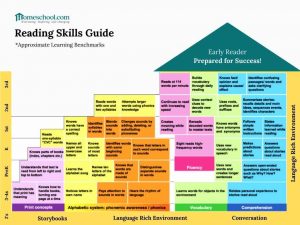When first considering homeschooling, it can definitely seem like a daunting task. While we may feel more comfortable teaching certain subjects that we excelled in ourselves or even just enjoyed throughout our academic years, there are at least a couple that might give us pause. (Math, anyone?)
One such subject may be reading. We realize its importance and how it is the foundation that will be built upon for the rest of our children’s lives. While it can be quite an undertaking, it’s also a great privilege to be able to be the one to see the light come into your child’s eyes as they begin to understand these important concepts.
In this article, we will address some tips and strategies to help improve your child’s reading skills whether they be a pre-reader, beginning reader, or struggling reader. They can learn to read, and you can teach them. Let us help you get started!
How to Improve the Reading Skills of Your Pre-Reader
There is never a time that is too early to begin teaching your little ones to love books and reading! There have been several studies that show that reading to your baby/toddler/preschooler has an incredible impact on their vocabulary. It doesn’t matter if they are too little to understand or even do much more than babble along; they are getting more than we realize. So the question becomes, What skills can we encourage to help our pre-readers get ready? 
Get Motivated
The best thing to encourage a love of reading in your child is to read to them! At least once every single day, sit down with your little one and read. You’ll be amazed at how quickly they’ll start looking forward to this time. Keep a shelf of their favorite books easily accessible to them. You may tire of them bringing you the same books to read over and over again but try not to let them know. Read with excitement and feeling to keep them interested.
Another easy thing you can do to motivate your children to read is to read yourself! If they see Mom or Dad reading and enjoying it, they’ll be more likely to find enjoyment in books themselves one day.
Be Descriptive
Once your child is old enough, have them retell their favorite story in their own words. Tap into their creativity and have them come up with stories of their own. When you read a new book or even an old one, ask lots of descriptive questions. All of these will encourage the expansion of their vocabulary and also give you a good idea of their comprehension level.
Practice Makes Perfect
Sometimes we take for granted that children automatically know how to do things, but they still need our guidance. Show them which way to hold a book, and how we read a page from left to right, and top to bottom. Point out the title, along with the author and illustrator’s names, and describe their purposes. Let them practice holding a book and gently turning pages. Use their finger to point to the words as you read them so they can follow along with where you are on the page. While it may seem redundant or unnecessary even, all these things are getting your little one ready to read!
Name That Letter
At a young age, begin introducing your children to the alphabet. Singing the ABC song is a great way to begin getting those letters in their brain. Don’t worry if they stumble through or think “elemeno” is a word stuck in there. There will be time to straighten that all out later.
As you read books, point out certain letters and tell them their name. Identify upper and lower case letters and the sounds they make. Reading alphabet books like “A is for Apple” or “Chicka Chicka Boom Boom” are great ways to begin teaching letters. Also, be sure to teach them the letters in their name and watch as they can identify those letters in other places. Again, they won’t retain all of this and immediately take off reading, but you are laying the first bricks of the reading foundation.
Name That Sound
As you’re teaching the letter names, begin teaching the letter sounds as well. This is vital to know before one can begin reading. Identifying the letters is great, but if you don’t know the sounds the letter makes, it won’t do much good when you’re staring at a page full of letters. This skill, the ability to recognize and work with sounds in spoken language, is called phonological awareness.
It’s a big term with a simple teaching method: read rhyming books! Point out the matching sounds in the words, and ask them if they can find words that rhyme as you’re reading. Dr. Seuss’s books are excellent for teaching phonological awareness. For example, in “One Fish, Two Fish, Red Fish, Blue Fish,” you can show them that “two and blue” have the same ending sound, while also asking what sound they hear at the beginning of the word “fish.” Be sure to exaggerate the “Fffffff” sound as you read the word, and see if they can pick it up to repeat it to you.
By implementing these 5 simple strategies, you are setting up your pre-reader for future success. For another take or a fun way to continue the learning, read this article from Time4Learning on using LEGO® bricks to boost reading skills! These suggestions will not only work for your pre-reader, but they will help your beginning or struggling reader as well…and who doesn’t love LEGOs?!
How to Improve the Reading Skills of Your Beginning Reader
Your child is now old enough and is showing further interest in learning to read. Great! …but now what? By focusing on teaching these 5 areas, you may be surprised as you watch your child have that “lightbulb moment” when things begin to click, and they take off on their reading adventure!
Focus on Phonemic Awareness
Phonemic awareness is a part of the more broad term of phonological awareness. As we covered in the previous section, your pre-reader should have a jump on this by being able to notice and identify rhyming words, matching sounds, and things like that. Phonemic awareness focuses more on counting syllables in words and being able to manipulate sounds.
Most of us probably learned how to identify the number of syllables in a word by clapping or snapping, and while those are perfectly acceptable methods, the beauty of homeschooling is you get to be as creative as you want to be! (The Time4Learning article above mentions a way to use LEGO® bricks to teach syllables!)
An example of manipulating sounds would be blending sounds together or changing the beginning or end of a word to create a new word. For instance, “s + ad = sad.” Ask your child what sounds can be changed to make new words. They may come up with actual words like Mad, Bad, Lad, Fad, Dad, etc., and they may come up with nonsense words like Crad, Thad, Plad, Frad, Wad (not to be confused with “wad” …The English language is something else, but that’s another article for another day). You can definitely point them out, but don’t discourage the nonsense words. At this stage, the focus is on them being able to notice and create the different sounds.
Focus on Phonics
There are a lot of similarities between phonemic awareness and phonics. Both involve blending sounds, but the main difference is that phonemic awareness has to do mainly with hearing the different sounds and words, while phonics involves seeing the relationship between these sounds and written words. For example, in phonics, you begin to point out the letters that make the sounds, like ch-, th-, st-, wh-, etc.
Creating blend charts may be helpful for your child to see and read words with the same sounds. Go over them every day until they can identify the simple word just by looking at it. Teaching phonics also involves teaching that words may look different, but have the same sound, like bird, word, heard, and curd.
This may be a good time to stop, take a breath, and have a little pep talk. I know this can seem overwhelming because our language is so complicated, but your children will get it. It won’t happen overnight, so don’t have that expectation. Take it a day at a time. Keep reading books to them, and point out words or sounds you’ve been working on.
Try not to get frustrated (easier said than done sometimes, I know). You don’t want your child to catch that frustration and assume that they just can’t do it. They will get there. As we said in the beginning, your child can learn to read, and you can teach them to do so. You’re not alone. We’re here to help! Feel better? I hope so. Okay, moving on…
Focus on Fluency
An easy definition of fluency is reading the way you speak. The best way to teach this is by modeling it. When you read, read with expression and have them follow along with their finger. Encourage them to read slowly instead of rushing to get through. When children are first learning to read, it is important for them to take their time with the words to ensure accuracy. Again, you’re focusing on them reading the way they would normally speak. Some of us Southerners may have a slower reading and speaking speed than others, but that’s okay. You simply want the reading to sound natural and accurate.
Suggested Products
Focus on Comprehension
Comprehension is understanding what is being read. We can read over many things while daydreaming, get to the end of a page, and have no idea what we just read. I’ve done that more times than I care to admit. If we can do it as adults, it can definitely be done by our children who are just learning to read.
There are many ways to focus on improving your child’s comprehension. Before reading a book, take a “picture walk.” Show them each page so they can look at the pictures. That way, they can begin to form an idea of what they think the story will be about.
Another strategy is to simply ask your child lots of questions. After (or even while) reading the book, talk about the context. ” Where and when did it take place? What’s happening on this page? Do you remember the main character’s name? What was his favorite (fill in the blank)? What do you think will happen next?” By asking questions, you’re involving your little one in the story, and they are much more likely to retain information.
Focus on Vocabulary
Before reading a new book, point out new words that they may not have heard before and explain their meaning. You want to make sure they have the new information before reading to aid in context and comprehension. Identifying and defining these new terms will also aid them in their ability to create their own stories. You can also take the opportunity to tell them other words with similar meanings. For example, happy could be replaced with excited, ecstatic, thrilled, etc.
How to Improve the Reading Skills of Your Struggling Reader
There are few things more discouraging to a parent or a teacher than seeing a child struggle with a subject to the point of shutting down, deciding they just can’t do it, and giving up. My son isn’t quite old enough for our homeschooling to begin, but I saw this happen many times over the years I worked in a classroom.
When a child struggles in a subject, whether it be math, reading, or something else, the best thing you can do is try to curb that frustration before it reaches the “I can’t do this so I’m not even going to try” level. If you’re already there, don’t lose heart. You can walk it back. Take breaks if it gets to be too much, get creative in your approach, and reassure your child at every opportunity of your faith in their ability to learn to read and excel in their reading.
Create Feasible Goals
If your child is struggling to read, you wouldn’t have a few refresher lessons, hand them a chapter book, and tell them to read it. They would immediately say, “I can’t do that!” No, You set small, attainable goals. Aiming too high too fast would be detrimental to their already shaky confidence. Go as far back to the beginning as necessary and take it a step at a time. Give them goals to shoot for that they can actually reach so they see progress and it boosts their self-esteem.
Read and Reread
If you have a struggling reader, don’t just turn them loose with a book or section in their textbook. Read it to them first. Ask questions so they can better grasp the meaning. Point out words they may have trouble sounding out or recognizing. Do all these things before they attempt to read the text for themselves. Again, comprehension is the goal here, and repetition is a great way to get there.
A great tip from one of our “Master Teachers” on our team is to buy some colored page protectors and cut them into strips. If your child has difficulty with keeping their place while reading, by placing the strip over the book, the color will highlight the words so their eyes can better follow along.
Find an Audience 
If your child gets embarrassed or frustrated by reading aloud, like so many other things in life, the only way to improve is to practice, practice, practice! Have them read to a sibling, or set up an audience of their stuffies to practice reading aloud. One thing they may also enjoy is recording themselves. They can play it back and hear their voice. In my experience, that has done more to encourage improvement than other things.
Make it Exciting
This one is so important!! As a person who has always loved reading and devoured as many books as I could get my hands on, I would get so bothered when people told me that they (or their children) didn’t enjoy reading. My passionate response is always, “You don’t dislike reading… You’re just not reading the right books!”
I know that schools and perhaps your homeschool curriculum require that certain books be read, but we aren’t in a traditional school, and YOU are in charge! If the goal is to improve your child’s reading skills and hopefully have them fall in love with the written word, then cater to their interests! What do they love? If your son or daughter loves sharks, princesses, trains, unicorns, space, superheroes, or Minecraft, put those books in their hands! Take a field trip to the library and let them find books they want to read.
When I was little, my personal favorites were Mandie books and Nancy Drew. Even now as an adult, I’m more drawn to fiction and mysteries than nonfiction, but I love the information I can glean from biographies and other nonfiction books. All that to say, please don’t worry that your child will only ever read silly books if you let them read them right now. When they’re first learning or struggling, the best way to encourage them to read is to let them be excited about the subject of the book.
Create a Word Wall or Board
This is one suggestion that falls into the “get creative” aspect that homeschooling can bring. Take a break one day from the regular routine, grab a camera or phone, drive or walk to town, and take a walk with your struggling reader. Let them be in charge of the camera or phone and instruct them to take pictures of words they see, especially if it’s words they have difficulty recognizing when reading a book or text.
Once finished, print the pictures of the words and have them put the photos on a wall or board in your school area for future reference. Your child may see the word pharmacy in a book and not be able to read it, but they can look at the sign for a pharmacy and know the word. With their word wall or board available for easy access, it will help with word recognition. This activity can be repeated as often as necessary to replace words as they are learned.
Download your copy of our Reading Skills Guide today!
Note that the ages/grades are approximate. Just remember that every child learns at their own pace, and that’s okay.
Book Lists for Your Readers
Reading together is one of the best ways to help your child improve their reading. If you’re looking to add more reading to your home, we have lists of seasonal favorites like Fall, Easter, and Christmas books here. If you’re looking for books that make us human, teach character, or motivate your readers, we also have lists of those. Whether you want book series, chapter books, or wholesome read-alouds, we can help you get started!





